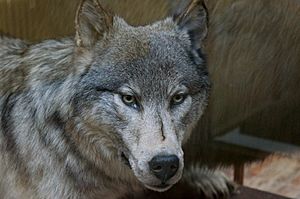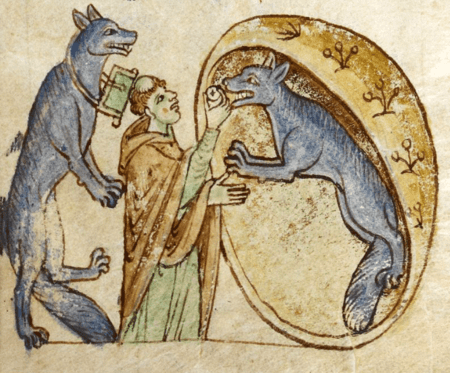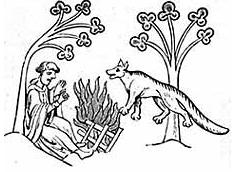Wolves in Ireland facts for kids

The grey wolf (Canis lupus) was once a big part of the Irish countryside and its culture. Sadly, these amazing animals are now extinct in Ireland. The very last wild wolf in Ireland is thought to have been killed in 1786. This was about 300 years after they disappeared from England and 100 years after they vanished from Scotland.
Contents
Irish Wolf Stories and Myths

Wolves appear a lot in Irish mythology. For example, Airitech was a mysterious creature. His three daughters were like werewolves. They were eventually killed by a hero named Cas Corach.
The Irish word for wolf is Mac Tíre. This means "Son of the Countryside." There are many old Irish stories about people changing into wolves or other animals.
The Morrígan, a powerful goddess, was said to turn into a red-furred wolf. She did this especially when fighting the hero Cú Chulainn. Another story tells of Mac Cecht who killed a wolf. This wolf was eating a woman who was still alive on a battlefield.
It's also said that Cormac mac Airt, a famous king, was raised by wolves. He could even understand their language! Four wolves helped him in a fight against Lugaid mac Con. They stayed with him for the rest of his life.
One old tale from AD 1182 tells of a priest traveling in Ireland. He met a talking wolf! The wolf said he was a man from Ossory. His family had a curse: they turned into wolves every seven years. After another seven years, they would turn back into humans. The wolf's wife was dying, and he asked the priest to give her a special blessing. The priest helped, and the grateful wolf showed him the right way to his destination.
Wolves in Irish History
Ancient Times
The grey wolf (Canis lupus) is a type of dog from the group called Carnivora. Wolves are top predators. They mostly eat large plant-eating animals like deer.
The oldest wolf bones found in Ireland are from Castlepook Cave in County Cork. They are about 34,000 years old! Other wolf bones found in caves in Cork, Waterford, and Clare show that wolves lived all over Ireland during the last ice age. This ice age was coldest between 20,000 BC and 18,000 BC.
Around 14,000 BC, Ireland became a separate island from Great Britain. Wolves were one of the few land animals in Ireland that survived a very cold period called the Nahanagan Stadial. This happened between 10,800 BC and 9500 BC.
Wolves were a big part of Ireland's animal life after the ice age. We know this because they are in so many old Irish myths and legends. Their names are also in many place names, both Irish and English. We also find their bones at old human sites and in many historical writings.
Wolves and People Through Time
One of the earliest stories of wolves attacking people in Ireland is from AD 1137. It says, "The Blind one of... that is, Giolla Muire, was killed by wolves." Later, in AD 1420, another record states, "Wolves killed many people this year."
During the 1500s, many wolfskins were sent from Ireland to Bristol, England. Records show that between 100 and 300 wolfskins were exported each year. In one year, 961 skins were sent!
After the Nine Years' War (around 1600), Ireland faced terrible hunger. Many people died. Wolves, also hungry, came out of the woods and mountains. They attacked people who were weak from starvation.
In the early 1600s, Ireland had many wolves. There were probably between 400 and 1,000 wolves at any time. Because of this, Ireland was sometimes called "wolf-land."
The End of Wolves in Ireland
The first laws against Irish wolves were made in 1584. The government wanted to encourage people to kill wolves. More laws followed in 1610 and 1611. In 1614, a man named Henric Tuttesham was offered £3 for every wolf he killed. There were so many wolves that he was allowed to have four men and 24 hounds (hunting dogs) in every county for seven years!
Most of the laws against wolves came after the Cromwellian wars (1641-1652). During these wars, much of the country was destroyed. As more farm animals were raised, wolf numbers seemed to grow. They were seen as a danger to farms and businesses.
Oliver Cromwell's government offered large rewards for killing wolves. This brought professional wolf hunters to Ireland, mostly from England. The government also made it illegal to send Irish Wolfhounds out of the country. These large dogs were very good at hunting wolves.
In 1652, Cromwell's government set high rewards for wolf kills. They paid £6 for a female wolf, £5 for a male, £2 for a young wolf, and 10 shillings for a cub. In one area, over £243 was paid for wolf kills in 1655 or 1665. Between 1649 and 1656, a total of £3,847 was paid for wolf kills across Ireland.
By the 1690s, only a few wolves were left. Rory Carragh was hired to kill the last two wolves in one part of Ulster. The last reliable sighting of a wolf in Ireland was in County Carlow in 1786. This wolf was hunted down and killed near Mount Leinster after it killed sheep.
Bringing Wolves Back?
Today, you can see captive wolves at Dublin Zoo and the Wild Ireland nature reserve in the Inishowen Peninsula.
In 2019, a politician named Eamon Ryan suggested bringing wolves back to Ireland. He thought it could help nature and control the number of deer. However, the Irish government does not have plans to do this right now.


